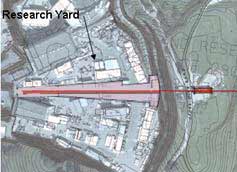
Handy Links
SLAC News Center
SLAC Today
- Subscribe
- Archives: Feb 2006-May 20, 2011
- Archives: May 23, 2011 and later
- Submit Feedback or Story Ideas
- About SLAC Today
SLAC News
Lab News
- Interactions
- Lightsources.org
- ILC NewsLine
- Int'l Science Grid This Week
- Fermilab Today
- Berkeley Lab News
- @brookhaven TODAY
- DOE Pulse
- CERN Courier
- DESY inForm
- US / LHC
SLAC Links
- Emergency
- Safety
- Policy Repository
- Site Entry Form

- Site Maps
- M & O Review
- Computing Status & Calendar
- SLAC Colloquium
- SLACspeak
- SLACspace
- SLAC Logo
- Café Menu
- Flea Market
- Web E-mail
- Marguerite Shuttle
- Discount Commuter Passes
-
Award Reporting Form
- SPIRES
- SciDoc
- Activity Groups
- Library
Stanford
Around the Bay
Designing LCLS for the Future
 Designing and building the Linac Coherent Light Source (LCLS) will be a monumental
challenge. Compounding that challenge is how to design it so that it can
keep pace with future discoveries—namely, discoveries related to how free electron
lasers work in the first place.
Designing and building the Linac Coherent Light Source (LCLS) will be a monumental
challenge. Compounding that challenge is how to design it so that it can
keep pace with future discoveries—namely, discoveries related to how free electron
lasers work in the first place.
The original design concept involved building the LCLS as simply as possible. But when the Office of Science gave the final go-ahead to begin the design phase in late 2002, the message was clear: build the LCLS so that future researchers can make use of new discoveries as they go along, without having to build a new laser from scratch.
The first generation LCLS will have a single undulator and beamline, giving physicists and engineers time to learn how free electron lasers work.
But the final design now includes a system of concrete shielding, called the "head house," that extends from the end of the linac and can eventually house multiple undulators to create multiple beamlines. That shielding will flare out several degrees on either side of the main beam, creating what Director of LCLS Construction John Galayda calls a "pilsner glass" shape. Future researchers will have room to add up to five more undulators for a total of six beamlines.
"This demonstrates the Department of Energy has a clear, long-term commitment to SLAC as a center of excellence for ultra-fast x-ray science," Galayda said.
Construction crews are currently dismantling the Final Focus Test Beam facility in the main research yard to accommodate the wider beam shielding.
óBrad Plummer
SLAC Today, June 6, 2006
Image: Diagram of the head house shielding, showing the initial LCLS beamline (in red) and the flared design (in pink) that will accommodate additional undulators and beamlines in the future.